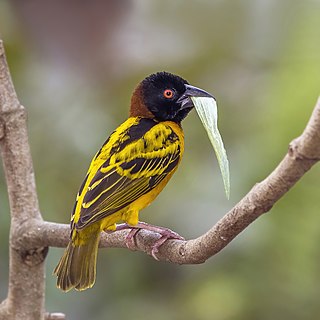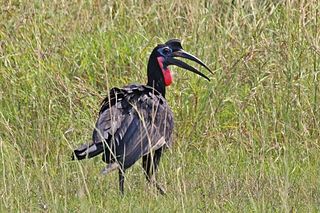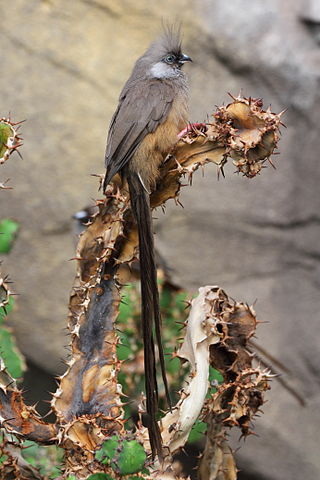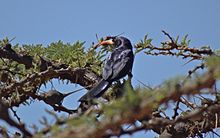
Honeyguides are a family of birds in the order Piciformes. They are also known as indicator birds, or honey birds, although the latter term is also used more narrowly to refer to species of the genus Prodotiscus. They have an Old World tropical distribution, with the greatest number of species in Africa and two in Asia. These birds are best known for their interaction with humans. Honeyguides are noted and named for one or two species that will deliberately lead humans directly to bee colonies, so that they can feast on the grubs and beeswax that are left behind.

The wood hoopoes or scimitarbills are a small African family, Phoeniculidae, of near passerine birds. They live south of the Sahara Desert and are not migratory. While the family is now restricted to Sub-Saharan Africa, fossil evidence shows that it once had a larger distribution. Fossils attributed to this family have been found in Miocene rocks in Germany.

The southern ground hornbill is one of two species of ground hornbill, both of which are found solely within Africa, and is the largest species in the hornbill order worldwide. It can be found in the southern regions of Africa, ranging from Kenya to South Africa. Within these regions, they inhabit both woodlands and savannas. The other species of the genus Bucorvus is the Abyssinian ground hornbill, B. abyssinicus.

The African grey hornbill is a member of the hornbill family of mainly tropical near-passerine birds found in the Old World. It is a widespread resident breeder in much of sub-Saharan Africa and the southwest of the Arabian Peninsula. The African grey hornbill has escaped or been deliberately released into Florida, USA, but there is no evidence that the population is breeding and may only persist due to continuing releases or escapes.

The greater honeyguide is a bird in the family Indicatoridae, paleotropical near passerine birds related to the woodpeckers. Its English and scientific names refer to its habit of guiding people to bee colonies. Claims that it also guides non-human animals are disputed.

The village weaver , also known as the spotted-backed weaver or black-headed weaver, is a bird species in the family Ploceidae found in much of sub-Saharan Africa. It has also been introduced to Portugal and Venezuela as well as to the islands of Hispaniola, Martinique, Puerto Rico, Mauritius and Réunion.

The Abyssinian ground hornbill or northern ground hornbill is an African bird, found north of the equator, and is one of two species of ground hornbill. It is the second largest species of African hornbill, only surpassed by the slightly larger southern ground hornbill.

The blue-naped mousebird, also formerly called the blue-naped coly is a species of bird belonging to the family Coliidae within the order Coliiformes. They are the sister group to the clade Eucavitaves, which contains the families Leptosomiformes, Trogoniformes (trogons), Bucerotiformes, Piciformes and Coraciformes.

The speckled mousebird is the largest species of mousebird, as well as one of the most common. It is found throughout most of Central, Eastern and Southern Africa.

Bucerotiformes is an order of birds that contains the hornbills, ground hornbills, hoopoes and wood hoopoes. These birds were previously classified as members of Coraciiformes. The clade is distributed in Africa, Asia, Europe and Melanesia.

The baglafecht weaver is a species of weaver bird from the family Ploceidae which is found in eastern and central Africa. There are several disjunct populations with distinguishable plumage patterns. Only some races display a discrete non-breeding plumage.

The grey-capped social weaver is a sparrow-like liver-colored bird, with a pale grey crown, a dark grey bill, a whitish eye-ring, horn-colored legs, with some black in the wing and a light terminal band in the tail, that builds roofed nests made of straws, breeds in colonies in thorny Acacia trees, and feeds in groups gathering grass seeds and insects. Male and female have near identical plumage. DNA-analysis confirms it is part of the weaver family. It is found in Ethiopia, Kenya, Somalia, South Sudan, Sudan, Tanzania, and Uganda.

The black-capped social weaver is a sparrow-like species of bird that has been assigned to the weaverbird family. It was originally described by Fisher and Reichenow, and later re-classified by the latter to the genus Pseudonigrita. Adults have a large black cap, ivory-colored bill, red eyes, brown back and wings, blackish-brown tail, white throat and underparts with a black midline, and dark horn-colored legs. It breeds in colonies and roofed nests with an entrance at the bottom in thorny trees such as acacias are constructed by the male from grass stems. It is found in parts of Ethiopia, Kenya, Somalia, and Tanzania. It is sometimes kept and bred in captivity.

The least honeyguide is a small species of bird in the family Indicatoridae. It is found in sub-Saharan Africa.

The lesser honeyguide is a species of bird in the family Indicatoridae. Like other honeyguides, it is a brood parasite that lays eggs most commonly in the nests of African barbets, but will also occasionally use the nests of other birds as well, such as starlings and woodpeckers.

The scaly-throated honeyguide is a species of bird in the family Indicatoridae. They have a mutualistic relationship with humans in which they attract beekeepers towards bees' nests and then feeding on the remains, especially larvae.

The Abyssinian wheatear, or Abyssinian black wheatear, is a species of bird in the family Muscicapidae, the Old World flycatchers and chats. It is found from Ethiopia to southern Kenya and north-eastern Tanzania.

The African hoopoe is a species of hoopoe in the family Upupidae. Previously considered as a subspecies of the Eurasian hoopoe, it is a resident species of southern Africa.




















